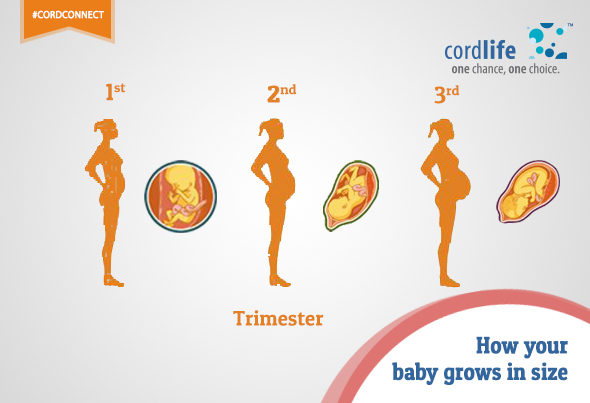Table of Contents
Your unborn is a tremendous source of anxiety and joy for you, all at once. You excitedly await your baby’s arrival, watching for the first signs of a baby bump that you can proudly flaunt to the world. It is still early days for the bump to show – you are probably in the first two months of your pregnancy – so it is not easy to know how fast your baby is growing.
Let’s give you a little heads-up on your baby’s development in each trimester:
First trimester
Your baby actually starts developing from the very first day of conception, but the progress is too minute to detail. The zygote (formed from a fertilised egg) carries 46 chromosomes that determine how your baby will look, what’s its gender will be, etc. By week 4, a pregnancy test should come back positive because the baby has by now developed into an embryo and is anchored to the uterus. From here on, your baby grows from a pin-head sized organism into a two-inch foetus at the end of your first trimester. The baby will have developed a placenta, a minute heart with a discernible heartbeat and the first signs of internal organs.
Second trimester
The baby’s development continues its steady progress when Month 4 comes along. You will notice the first signs of a rounded belly in the second trimester, but it will not be till Month 5 that you will really begin to show the pregnancy. Meanwhile, your baby grows from three inches (measuring from head to bottom), with its head being the biggest part of its body. The baby also develops the first vestiges of muscles, tiny feet and hands and the torso begins to elongate so that the baby grows in height as well. By the end of the second trimester, the baby begins to move inside the womb and also kick. You can feel these kicks initially as a fluttering, but the kicking becomes more pronounced by Month 6. Neural development begins in earnest during this time.
Third trimester
Your baby’s development kicks into high gear in the last trimester. The baby grows up to 17 inches long by the time the 32nd week comes along. The bones, internal organs and limbs show the most growth, though the bones are still quite soft and pliable. The baby also shows the first signs of breathing inside the womb, though the lungs continue to mature right till the time the baby is delivered. Fat begins to deposit on the baby, and it also kicks much more than before. Your baby is able to open and close its eyes and respond to sounds and light stimulus. By Week 36, the baby shifts to the head-down position and by this time, it is said to be ‘full term’. You will notice your baby’s weight the most during this time, and finally, the birthing process begins when the baby’s head starts pressing against the pelvis to induce contractions.
